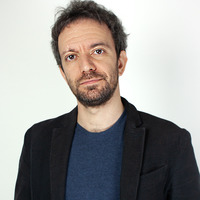PhD in Philosophy, École Pratique des Hautes Etudes (religious sciences) & University of Bucharest (political sciences).
Postodoctoral Fellow Institute for Research in the Humanities (IRH-ICUB), University of Bucharest
Postodoctoral Fellow Institute for Research in the Humanities (IRH-ICUB), University of Bucharest
less
Related Authors
Martin Grassi
Pontificia Universidad Católica Argentina
ovidiu Panaite
Universitatea "1 Decembrie 1918" Alba Iulia
Roberto Revello
Università degli Studi dell'Insubria
Emiliano Rubens Urciuoli
Università di Bologna
Fedor Nekhaenko
Cornell University
Luca Pellarin
Universität Erfurt
Samuel Pomeroy
University of Tennessee Knoxville
Elisabetta Colagrossi
University of Genoa
Giulio Battioni
Università degli Studi "La Sapienza" di Roma
Yulia Prozorova
University of Toronto
InterestsView All (34)











Uploads
Papers by Ana Petrache
Le point de départ de ce volume est la blessure, signe de la
vulnérabilité et de la fragilité de l’être humain. Qu’il s’agisse de
blessures causées par des actes violents, foncièrement injustes,
ou de blessures issues de maladies, les traditions religieuses
proposent des chemins de guérison. Réfléchir à partir des
blessures et à travers elles n’est pas une tâche aisée, car cette
réflexion implique d’intégrer la négativité, la souffrance et la
douleur, tout en portant l’espoir de leur dépassement. Ce
volume invite à une discussion autour des ressources de
guérison et des mécanismes thérapeutiques que les religions
— notamment le bouddhisme, le judaïsme, le christianisme et
l’islam — peuvent offrir.
abrahamiques » utilisé dans le dialogue interreligieux peut être remplacé par
une meilleure expression : les religions eschatologiques. Ce terme est nouveau,
ainsi que l’argumentation qui suit : ce qui rend le christianisme, le judaïsme et
l’islam similaires n’est pas un monothéisme théorique, ni les racines
abrahamiques, mais leur orientation eschatologique commune, la recherche
d’une communauté réconciliée dans les temps à venir. Il ne s’agit pas seulement
des promesses et des attentes pour l’au-delà, un espoir de résurrection et de vie
éternelle et la peur du jugement, c’est plutôt le fait que ces trois religions ont
promu une manière de penser orientée vers l’accomplissement des prophéties
et qu’elles partagent l’hypothèse que cette parole et ce temps auront tôt ou tard
une fin. Une telle conception implique trois caractéristiques qui méritent d’être
mentionnées : tout d’abord, l’être humain est orienté eschatologiquement, il
regarde vers les choses à venir, pour advenir . Ensuite, cette orientation permet une « phénoménologie de l’espérance humaine, originaire de ce monde, mais orientée vers un autre » . Enfin, les caractéristiques mentionnées ci-dessus sont les raisons pour lesquelles les croyants sont dans un état de préparation anticipée de la fin en menant une vie morale convenable .
Carl Schmitt, Gaston Fessard and Johan Baptist Metz. So far, no study has been done
concerning the polemical concept of false eschatology. Zooming in on the concept of
false eschatology, based on a progressive philosophy of history, refusing the idea of
an end of time and appearing in three different models of political theology, this paper
argues that eschatological imagery is essential in the construction of political theology
and, moreover that, a false eschatology might be responsible for false political theologies. Through the mediation of the Hegelian Aufhebung, secularization is to be understood as a dialectic process, who immanentizes the eschaton in different political
theologies. While the three authors agree concerning the meaning of secularization,
they disagree concerning eschatological imagery and these differences may explain
different political theologies.
the biblical literature. They challenge a given political reality by encouraging people to resist it and by
recalling that present political power and injustice cannot be eternal. These narratives remind that the
present time should not be given a privileged status over the past and the future. My article starts from
the observation that the projections concerning the future in general and especially eschatological imagination are recurrent themes in both religion and science fiction. The look towards the future represents
the common ground between the narrative of Judeo-Christian tradition and science fiction literature.
These narratives challenge the present based on a promise or threat of a future that is not there. Apocalyptic references challenge a certain political power based on an ‘ontology’ of non-existence (or not yet
being). The paper compares different ways of questioning political power in theology and science fiction
by emphasizing the role of apocalyptic imagination.
eschatology and political theology works. More specifically, I want to focus on how different political
theologies are determined by different visions about
what the Kingdom is and when it will be achieved. I
choose to focus on two political theological narratives,
each with its own different political background and
cultural heritage: a Catholic, leftist, Latin American
perspective in comparison with an Orthodox, conservative, Eastern European perspective.
thinkers who within the Francophone space has drawn a strict parallelism between Communism and Nazism as early as the 30s. The present paper analyses the way in which Fessard discusses about the temporal mystique with which both Nazism and Communism seek to substitute traditional religions. An original element is his defining totalitarianism starting from the religious enemy: Judaism for the Nazi and Christianity for Communism. The first part of the paper discusses the language employed when analyzing secular religions, while the second part insist on the structure of Marxism as onto-a-theology, built around a project of secular redemption which has its own chosen people - the labourers - innocent of the guilt of owning any private property, which carries with itself a utopic project described as the end of all alienation and as the unity between man and nature, designed to replace the Christian unity between man and God.
theology on the Spiritual Exercises of Saint Ignatius of Loyola,
according to Gaston Fessard’s (1897-1978) interpretation of St.
Ignatius and Hegel. Following the Ignatian model, Fessard
emphasized the importance of defining religious experience as an
incarnation of the theological truth in life. In a similar way, for a
Christian, political decisions should reflect the social doctrine of the
Church. The discussion is timely and relevant because it emphasizes
the possibility of building a political theology in close relationship
with the doctrine of the church. Recently, Dominique Bertrand has
showed that Saint Ignatius itself had a system of correspondence
meant to offer discernment of spirit for political and economic
decisions.
In recent years, there has been a revival of the practice of lay
Spiritual Exercises. In this context, this article seeks to examine the
possibility of establishing a political theological framework according
to the methods proposed by Fessard. It examines the limitations and
pitfalls of such a political theology and the relations between this new
method and the social doctrine of the church.
Fessard shows exactly how this principle of discernment can
be used to lighten different political situations. For example, during
France’s Occupation Fessard wrote a moral guide dedicated to the
archbishop of Paris; the Jesuit was well known in catholic circles
concerning the resistance against the Nazi. Although Fessard argues
that social doctrine of the church is the abstract guide for concrete
political decisions, in practice Fessard himself criticized the same
social doctrine of the church as being corrupt in several respects. This
weakens his argument in favor of a Christian theology of politics
based on spiritual discernment.
narratives drive people to adopt a certain political behavior.
The article starts with Jürgen Moltmann’s ideas that there are
two main eschatological paradigms, the conservative and the
progressive one, and that both influence the way people take
real political decisions. These two eschatological paradigms
are discussed in relation with the concept of millenaries,
apocalypse and post-history. I elaborate a conceptual
framework and I argue that terrorist attacks and the reaction
of the state in response to terrorist attacks can be read and
understood in relation to eschatological narratives. This
argument is tested by discussing and comparing some
discourses of the French President François Hollande and
some discourses of the American President George W. Bush.
Despite their very different political ideologies, the two
Presidents share a very similar structure of their discourses:
they both present the State (France and USA) as the entity that
can stop the possible apocalypse unleashed by the terrorist
attacks. In theological terms, the state has a conservative
discourse promising to be the “katechon” that will postpone
the end. While the state uses the redemption paradigm to
promise protection, the terrorist statements of those groups
claiming the attack use another religious category which
revolves around the threat of the Judgement Day. Further, the
article analyses the terrorist claim made by the militants after
the attack on November 13th 2016 in Paris emphasizing how
2 Chapter Number
both the states and the terrorists challenge the “normal” legal
order, the first to preserve it, the former to destroy it. My
articles innovates by showing what are the hidden
eschatological assumptions used by the terrorist discourse and
how the state reacts by presenting it efforts as the “katechon”
meant to stop the apocalypse.
Pour ce faire, je me propose de prendre la pensée de Fessard – laquelle semble se construire en opposition directe à celles de ses contemporains – comme observatoire du phénomène du christianisme progressiste . Cette perspective pourrait certes paraître limitée, en ce que Fessard fut un critique sans appel des chrétiens de gauche, mais je considère que la richesse même de sa pensée viendra compenser cette limite.
Le point de départ de ce volume est la blessure, signe de la
vulnérabilité et de la fragilité de l’être humain. Qu’il s’agisse de
blessures causées par des actes violents, foncièrement injustes,
ou de blessures issues de maladies, les traditions religieuses
proposent des chemins de guérison. Réfléchir à partir des
blessures et à travers elles n’est pas une tâche aisée, car cette
réflexion implique d’intégrer la négativité, la souffrance et la
douleur, tout en portant l’espoir de leur dépassement. Ce
volume invite à une discussion autour des ressources de
guérison et des mécanismes thérapeutiques que les religions
— notamment le bouddhisme, le judaïsme, le christianisme et
l’islam — peuvent offrir.
abrahamiques » utilisé dans le dialogue interreligieux peut être remplacé par
une meilleure expression : les religions eschatologiques. Ce terme est nouveau,
ainsi que l’argumentation qui suit : ce qui rend le christianisme, le judaïsme et
l’islam similaires n’est pas un monothéisme théorique, ni les racines
abrahamiques, mais leur orientation eschatologique commune, la recherche
d’une communauté réconciliée dans les temps à venir. Il ne s’agit pas seulement
des promesses et des attentes pour l’au-delà, un espoir de résurrection et de vie
éternelle et la peur du jugement, c’est plutôt le fait que ces trois religions ont
promu une manière de penser orientée vers l’accomplissement des prophéties
et qu’elles partagent l’hypothèse que cette parole et ce temps auront tôt ou tard
une fin. Une telle conception implique trois caractéristiques qui méritent d’être
mentionnées : tout d’abord, l’être humain est orienté eschatologiquement, il
regarde vers les choses à venir, pour advenir . Ensuite, cette orientation permet une « phénoménologie de l’espérance humaine, originaire de ce monde, mais orientée vers un autre » . Enfin, les caractéristiques mentionnées ci-dessus sont les raisons pour lesquelles les croyants sont dans un état de préparation anticipée de la fin en menant une vie morale convenable .
Carl Schmitt, Gaston Fessard and Johan Baptist Metz. So far, no study has been done
concerning the polemical concept of false eschatology. Zooming in on the concept of
false eschatology, based on a progressive philosophy of history, refusing the idea of
an end of time and appearing in three different models of political theology, this paper
argues that eschatological imagery is essential in the construction of political theology
and, moreover that, a false eschatology might be responsible for false political theologies. Through the mediation of the Hegelian Aufhebung, secularization is to be understood as a dialectic process, who immanentizes the eschaton in different political
theologies. While the three authors agree concerning the meaning of secularization,
they disagree concerning eschatological imagery and these differences may explain
different political theologies.
the biblical literature. They challenge a given political reality by encouraging people to resist it and by
recalling that present political power and injustice cannot be eternal. These narratives remind that the
present time should not be given a privileged status over the past and the future. My article starts from
the observation that the projections concerning the future in general and especially eschatological imagination are recurrent themes in both religion and science fiction. The look towards the future represents
the common ground between the narrative of Judeo-Christian tradition and science fiction literature.
These narratives challenge the present based on a promise or threat of a future that is not there. Apocalyptic references challenge a certain political power based on an ‘ontology’ of non-existence (or not yet
being). The paper compares different ways of questioning political power in theology and science fiction
by emphasizing the role of apocalyptic imagination.
eschatology and political theology works. More specifically, I want to focus on how different political
theologies are determined by different visions about
what the Kingdom is and when it will be achieved. I
choose to focus on two political theological narratives,
each with its own different political background and
cultural heritage: a Catholic, leftist, Latin American
perspective in comparison with an Orthodox, conservative, Eastern European perspective.
thinkers who within the Francophone space has drawn a strict parallelism between Communism and Nazism as early as the 30s. The present paper analyses the way in which Fessard discusses about the temporal mystique with which both Nazism and Communism seek to substitute traditional religions. An original element is his defining totalitarianism starting from the religious enemy: Judaism for the Nazi and Christianity for Communism. The first part of the paper discusses the language employed when analyzing secular religions, while the second part insist on the structure of Marxism as onto-a-theology, built around a project of secular redemption which has its own chosen people - the labourers - innocent of the guilt of owning any private property, which carries with itself a utopic project described as the end of all alienation and as the unity between man and nature, designed to replace the Christian unity between man and God.
theology on the Spiritual Exercises of Saint Ignatius of Loyola,
according to Gaston Fessard’s (1897-1978) interpretation of St.
Ignatius and Hegel. Following the Ignatian model, Fessard
emphasized the importance of defining religious experience as an
incarnation of the theological truth in life. In a similar way, for a
Christian, political decisions should reflect the social doctrine of the
Church. The discussion is timely and relevant because it emphasizes
the possibility of building a political theology in close relationship
with the doctrine of the church. Recently, Dominique Bertrand has
showed that Saint Ignatius itself had a system of correspondence
meant to offer discernment of spirit for political and economic
decisions.
In recent years, there has been a revival of the practice of lay
Spiritual Exercises. In this context, this article seeks to examine the
possibility of establishing a political theological framework according
to the methods proposed by Fessard. It examines the limitations and
pitfalls of such a political theology and the relations between this new
method and the social doctrine of the church.
Fessard shows exactly how this principle of discernment can
be used to lighten different political situations. For example, during
France’s Occupation Fessard wrote a moral guide dedicated to the
archbishop of Paris; the Jesuit was well known in catholic circles
concerning the resistance against the Nazi. Although Fessard argues
that social doctrine of the church is the abstract guide for concrete
political decisions, in practice Fessard himself criticized the same
social doctrine of the church as being corrupt in several respects. This
weakens his argument in favor of a Christian theology of politics
based on spiritual discernment.
narratives drive people to adopt a certain political behavior.
The article starts with Jürgen Moltmann’s ideas that there are
two main eschatological paradigms, the conservative and the
progressive one, and that both influence the way people take
real political decisions. These two eschatological paradigms
are discussed in relation with the concept of millenaries,
apocalypse and post-history. I elaborate a conceptual
framework and I argue that terrorist attacks and the reaction
of the state in response to terrorist attacks can be read and
understood in relation to eschatological narratives. This
argument is tested by discussing and comparing some
discourses of the French President François Hollande and
some discourses of the American President George W. Bush.
Despite their very different political ideologies, the two
Presidents share a very similar structure of their discourses:
they both present the State (France and USA) as the entity that
can stop the possible apocalypse unleashed by the terrorist
attacks. In theological terms, the state has a conservative
discourse promising to be the “katechon” that will postpone
the end. While the state uses the redemption paradigm to
promise protection, the terrorist statements of those groups
claiming the attack use another religious category which
revolves around the threat of the Judgement Day. Further, the
article analyses the terrorist claim made by the militants after
the attack on November 13th 2016 in Paris emphasizing how
2 Chapter Number
both the states and the terrorists challenge the “normal” legal
order, the first to preserve it, the former to destroy it. My
articles innovates by showing what are the hidden
eschatological assumptions used by the terrorist discourse and
how the state reacts by presenting it efforts as the “katechon”
meant to stop the apocalypse.
Pour ce faire, je me propose de prendre la pensée de Fessard – laquelle semble se construire en opposition directe à celles de ses contemporains – comme observatoire du phénomène du christianisme progressiste . Cette perspective pourrait certes paraître limitée, en ce que Fessard fut un critique sans appel des chrétiens de gauche, mais je considère que la richesse même de sa pensée viendra compenser cette limite.
writings, which deals with the relationship between Nature, Man and Society, I will offer three interpretations of the subject. The first is submitted by a liberal critic of Marxism, student at the school of thought of Raymond Aron, Kostas Papaioannou. A Marxist trained in Frankfurt School, Alfred Schmidt, suggests the second, and the third is a catholic one, presented by a Jesuit, Gaston Fessard. All three point out that the relationship between Man and Nature is central to Marx’s vision of the world. The catholic interpretation pictures how using a Hegelian structure, Marx manages to change the traditional relationship between
Man and God to a new relationship Man / Nature. This modification explains why so many scholars spoke about Marxism in terms of political religion.